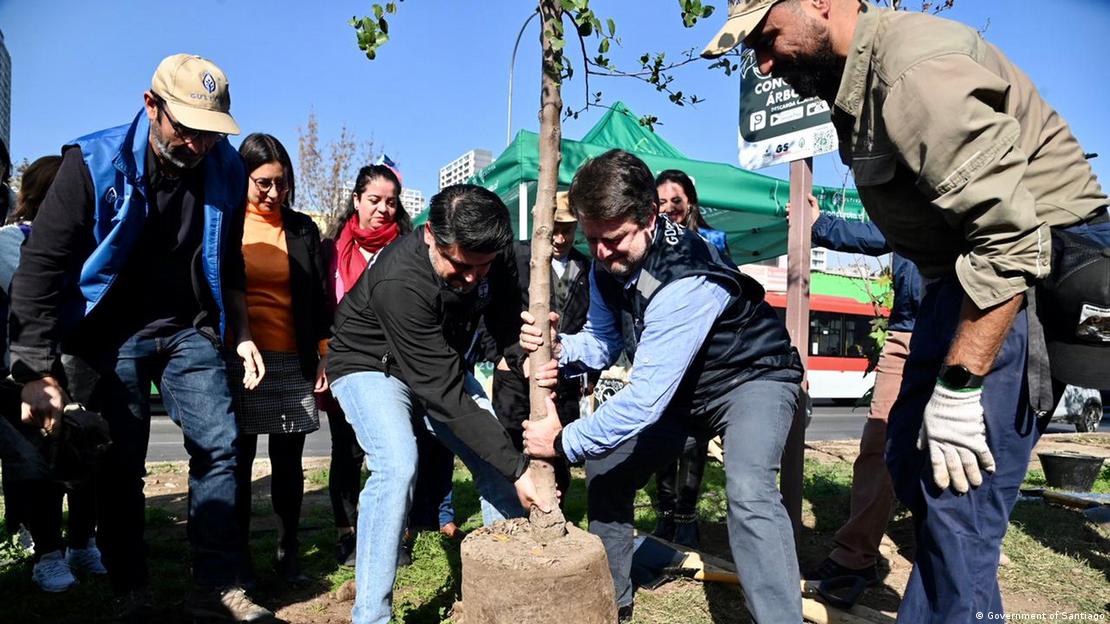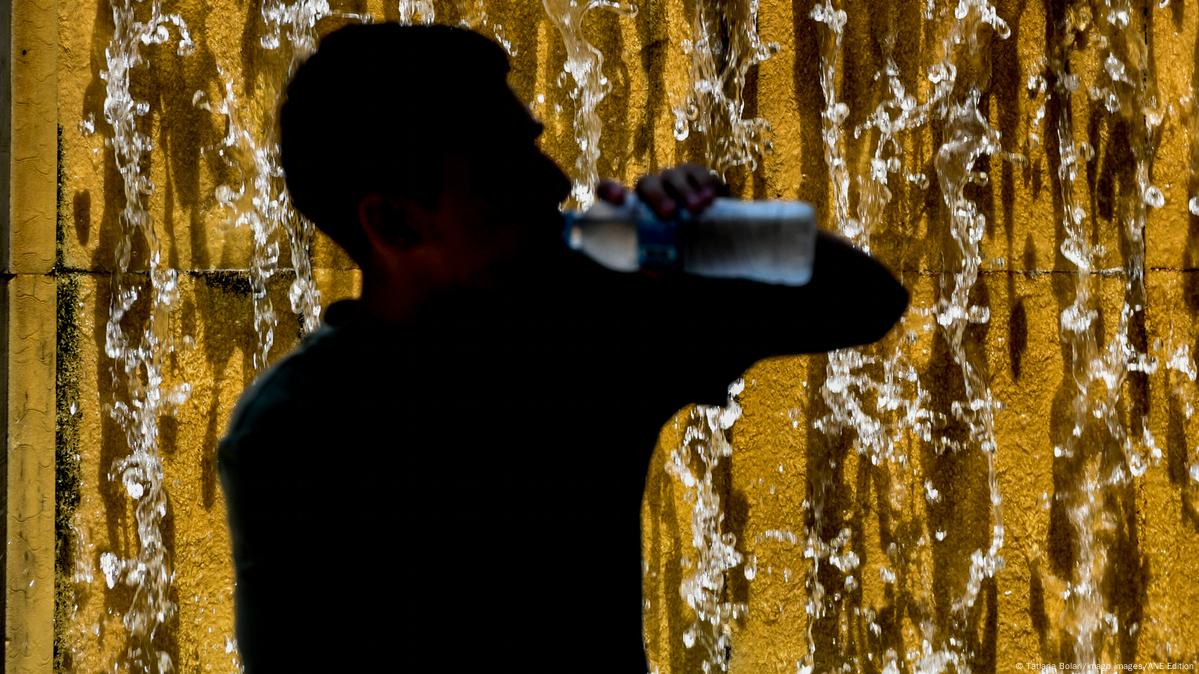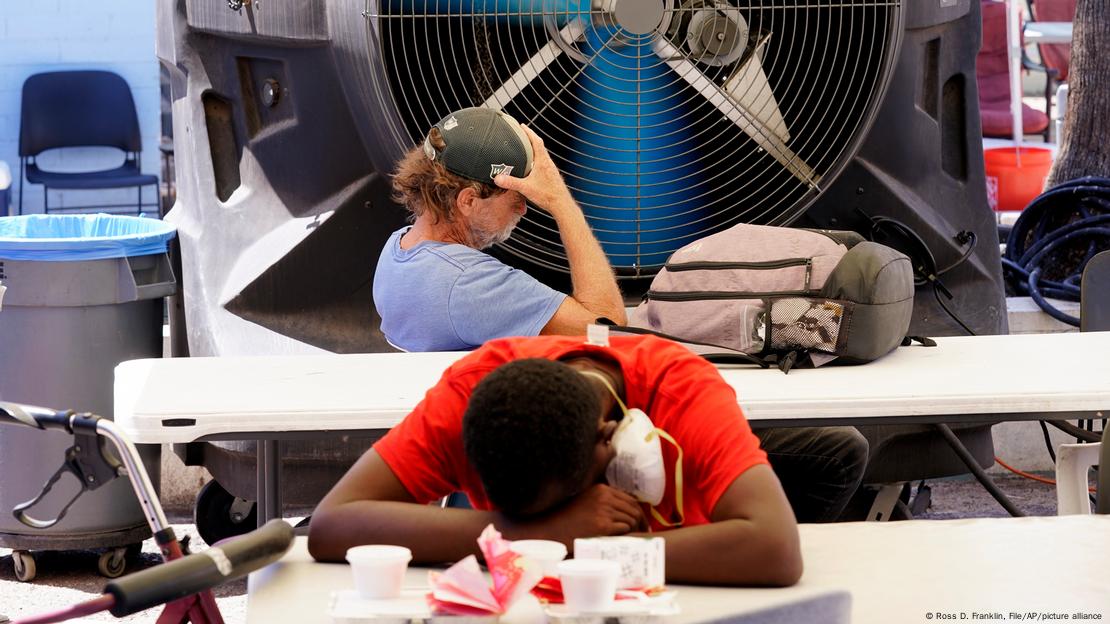Under current climate change policies, billions will face life-threatening heat. But a global network of heat officers are tackling the problem in their own cities.

Alistair Walsh
DW
How do hot temperatures harm human health?
Extreme heat can result in a range of illnesses and death, according to the World Health Organization (WHO). These include heatstroke and hyperthermia. Temperature extremes also worsen chronic conditions and have indirect effects on disease transmission, air quality and critical infrastructure.
The elderly, infants and children, pregnant women, outdoor and manual workers, athletes and the poor are particularly vulnerable to higher temperatures.
May 22, 2023
About 2 billion people will live in hazardous heat conditions by the end of the century if climate policies continue on their current trajectory, according to new research published in the Nature Sustainability journal. That represents 23% of the projected global population.
If the climate warms more drastically — a potential scenario under current policies — about 3.3 billion people could face extreme temperatures by the end of the century.
The study, led by scientists at the UK's University of Exeter and Nanjing University in China, found that 60 million people are already exposed to dangerous heat levels, characterized by an average temperature of 29 degrees Celsius (84.2 degrees Fahrenheit) or higher.
About 2 billion people will live in hazardous heat conditions by the end of the century if climate policies continue on their current trajectory, according to new research published in the Nature Sustainability journal. That represents 23% of the projected global population.
If the climate warms more drastically — a potential scenario under current policies — about 3.3 billion people could face extreme temperatures by the end of the century.
The study, led by scientists at the UK's University of Exeter and Nanjing University in China, found that 60 million people are already exposed to dangerous heat levels, characterized by an average temperature of 29 degrees Celsius (84.2 degrees Fahrenheit) or higher.
How do hot temperatures harm human health?
Extreme heat can result in a range of illnesses and death, according to the World Health Organization (WHO). These include heatstroke and hyperthermia. Temperature extremes also worsen chronic conditions and have indirect effects on disease transmission, air quality and critical infrastructure.
The elderly, infants and children, pregnant women, outdoor and manual workers, athletes and the poor are particularly vulnerable to higher temperatures.
Limiting warming to the lower Paris accord target of 1.5 degrees Celsius above pre-industrial levels would still expose 400 million people to dangerous heat levels by the end of the century, the study found.
People living in India, Sudan and Niger will all be heavily affected by even 1.5 degrees warming, but 2.7 degrees will have enormous effects on countries like the Philippines, Pakistan and Nigeria.
Calculating the human cost of climate change
Researchers said their study breaks the trend of modeling climate impacts in economic rather than human terms.
"It invariably distorts value away from human lives and towards centers of wealth," Ashish Ghadiali, a climate activist and co-author of the paper, told DW, adding that modeling focused on economics "places more value on a life in New York State than in Bangladesh."
Most other models also prioritize current populations over future ones, with inequality in global warming being "both globally distributed, but also intergenerational," said Ghadiali.
"It fundamentally values my life more than my children's lives and certainly more than my grandchildren's lives," he said.
Looking at individual country impacts on dangerous heat levels, researchers found that current emissions from 1.2 average US citizens condemn a future human to live in extreme heat. Despite having disproportionate emissions, the US population faces a much lower threat from dangerous temperatures.
How can people be protected from extreme heat?
Previous studies have shown cities are particularly vulnerable to such dangerous temperature rises, due to the "heat island effect." Buildings, roads and infrastructure absorb and radiate the sun's heat more than natural environments like forests and water bodies, raising urban temperatures by as much 15 degrees Celsius in some cases, compared to rural areas.

Santiago is planting 30,000 trees across the city and plans to establish 'pocket forests' to act as cooling centers
Image: Government of Santiago
Cities around the world are introducing the new role of chief heat officer to deal with inevitable temperature increases. One of those is Cristina Huidobro, who took up the post for Chile's capital Santiago in March 2022.
"Many cities in the world face extreme heat, but the solutions and the way you approach it are very, very local," Huidobro told DW.
Still, Huidobro said, they all broadly follow a three pronged strategy — preparedness, awareness and adaptation.
Preparedness can include categorizing heat waves in the same way as other natural disasters, or setting up an alert threshold to trigger a certain city response.
Huidobro said raising awareness of the dangers of heat are an integral part of the role.
"Taking care of yourself in an extreme heat event is really simple — drink water, seek shade and rest," she said. "Nobody has to die from extreme heat."
The third prong is adapting the city to the new reality of high temperatures, largely by creating more green spaces in the city.
Santiago has just launched an urban reforestation project to plant 30,000 trees across the city and develop strategies that treat the trees as part of the urban infrastructure.
"Trees, trees, trees, trees everywhere. It's bringing more green into the city," Huidobro said.
But planting trees isn't as easy as people think.
"We're putting trees in really dense streets, like in the main avenues of the city, where you have a lot of cement. You need to dig a hole and really do some civil works."
It's also not an instant solution to urban heat as trees need time to grow.
"The whole idea is to try to plant the shade that we're going to have in the next 20 or 30 years," said Huidobro.
How to stay hydrated in the summer sun
If summer temperatures in the high 40s Celsius (115+ F) get common, we had better watch our fluid levels more than ever. Here's how to prevent dehydration.
Cities around the world are introducing the new role of chief heat officer to deal with inevitable temperature increases. One of those is Cristina Huidobro, who took up the post for Chile's capital Santiago in March 2022.
"Many cities in the world face extreme heat, but the solutions and the way you approach it are very, very local," Huidobro told DW.
Still, Huidobro said, they all broadly follow a three pronged strategy — preparedness, awareness and adaptation.
Preparedness can include categorizing heat waves in the same way as other natural disasters, or setting up an alert threshold to trigger a certain city response.
Huidobro said raising awareness of the dangers of heat are an integral part of the role.
"Taking care of yourself in an extreme heat event is really simple — drink water, seek shade and rest," she said. "Nobody has to die from extreme heat."
The third prong is adapting the city to the new reality of high temperatures, largely by creating more green spaces in the city.
Santiago has just launched an urban reforestation project to plant 30,000 trees across the city and develop strategies that treat the trees as part of the urban infrastructure.
"Trees, trees, trees, trees everywhere. It's bringing more green into the city," Huidobro said.
But planting trees isn't as easy as people think.
"We're putting trees in really dense streets, like in the main avenues of the city, where you have a lot of cement. You need to dig a hole and really do some civil works."
It's also not an instant solution to urban heat as trees need time to grow.
"The whole idea is to try to plant the shade that we're going to have in the next 20 or 30 years," said Huidobro.
How to stay hydrated in the summer sun
If summer temperatures in the high 40s Celsius (115+ F) get common, we had better watch our fluid levels more than ever. Here's how to prevent dehydration.

If it's hot, keep your fluids up
We are 70% water. If our water drops to the point of dehydration, our bodies stop functioning. So, if you're out on a hot day, working, exercising or hiking, drink water before you get thirsty. How much you drink depends on what you're doing. But keep it regular, every 1-2 hours. Balance your fluids and food. Keep an eye on the kids.

Mind what you drink
The general idea is drink water. But it is more complicated than that. Stick to clear liquids like water or a broth. If you've got an oral rehydration solution, use that, but always read the packaging for guidance. And avoid diuretics — things that make you pee — like alcohol, coffee and tea, and sugary stuff like soft and sports drinks. They can cause diarrhea and make you lose even more fluids.
Spot the early signs of dehydration
Whether it's just you, or a child or an older person you're with, check yourself and them. Are you irritable or restless? Do they have sunken eyes, a rapid pulse, or are they drinking really, really fast? Pinch the skin. Does it go back slowly? Is your pee dark? Does it have a bad odor? Or does your breath smell? Well, then, there may be some level of dehydration. It's time to get help.Image: Colourbox/Alexey Poprotskiy
The signs of severe dehydration
Now the real danger signs: Are you or the person you're with lethargic or unconscious? Is their pulse absent or weak? Can you sense any respiratory distress? Are they wheezing, grunting, breathing rapidly, sweating, flaring their nose? And think about those early signs: Sunken eyes and dry skin that doesn't spring back when you pinch it. When you're already dehydrated it gets difficult to drink.
At risk: Babies, young kids and the elderly
It can happen to any of us. But babies, children and elderly people have a higher risk of dehydration. Diuretic medicines for reducing fluids or blood pressure can make dehydration more likely, as can some diabetes drugs. Check with your doctor. And, if you're with kids, check for drowsiness, fever, a dry or sticky tongue or mouth, crying without tears, or a dry diaper over three or more hours.
Routes to rehydration
It takes more than water. You need to replenish fluids, sugars, electrolytes — minerals like sodium, potassium, calcium, chloride, and phosphate that help the body and mind function. For mild cases, you may be able to take an oral rehydration solution. Other quick fixes: Fruits, vegetables, salty snacks and some say milk. In severe cases, you may need to be treated by a doctor or even in hospital.
The water's got to be clean
We still take water for granted in the richer nations. It's a luxury that people in poorer nations don't have — 1 in 3 people in the world lack access to clean water, and, in some of the least-developed countries, even health care facilities lack water service. Those are often the hottest places on Earth, making it tough for people to stay hydrated and healthy. Same for you if you're visiting
Don't overdo it
Drinking too much water can lead to overhydration, and that can be as bad as dehydration. It happens when your kidneys fail to process the fluid in your body. That can lead to low sodium levels, or hyponatremia. Sodium regulates the fluids in and around your cells. And if that fails, overhydration can cause fatal brain swelling. So, if your pee is always clear, hold back, you're drinking too much.Image: imago images/Panthermedia
Drinking too much water can lead to overhydration, and that can be as bad as dehydration. It happens when your kidneys fail to process the fluid in your body. That can lead to low sodium levels, or hyponatremia. Sodium regulates the fluids in and around your cells. And if that fails, overhydration can cause fatal brain swelling. So, if your pee is always clear, hold back, you're drinking too much.Image: imago images/Panthermedia
The US cities fighting extreme heat
The United States — where previous studies have found 12,000 people die prematurely from heat each year — has appointed three chief heat officers so far, in Phoenix, Miami and Los Angeles.
The Californian city of Los Angeles, which is ranked as the most susceptible to natural disasters including heat waves, recently launched a campaign to build more "resilience hubs" with shade and cooling powered by renewables in high-risk communities. It already has a network of cooling centers mainly in libraries, where people can go to beat the heat.
They are also working on an early warning system for heat waves.
Phoenix, a city in the middle of the Sonoran Desert, is working on a number of adaptations, including building cooling pavements with a special sealant that reflects the sun. The sealant makes paths several degrees cooler to the touch and keeps the night air cooler.

US cities, such as Phoenix, have networks of cooling centers to help people recover from heat
Ross D. Franklin, File/AP/picture alliance
The city of Miami in Florida is planning major urban tree-planting campaigns, and has also spent millions of dollars on air-conditioning units for public housing residents while providing financial assistance to help cover the energy bills of low-income households.
But Santiago's Huidobro said air-conditioning is generally a last resort for adaptation because of its climate impacts.
Santiago wants to plant 33 "pocket forests" that would be used as climate shelters, especially near schools and health facilities. These are an alternative to the air-conditioned cooling centers being developed in the US and Europe.
"During a heat wave people can go inside these nature-based cooling centers and get their shade, and rest and drink water," said Huidobro.
Edited by: Jennifer Collins
The city of Miami in Florida is planning major urban tree-planting campaigns, and has also spent millions of dollars on air-conditioning units for public housing residents while providing financial assistance to help cover the energy bills of low-income households.
But Santiago's Huidobro said air-conditioning is generally a last resort for adaptation because of its climate impacts.
Santiago wants to plant 33 "pocket forests" that would be used as climate shelters, especially near schools and health facilities. These are an alternative to the air-conditioned cooling centers being developed in the US and Europe.
"During a heat wave people can go inside these nature-based cooling centers and get their shade, and rest and drink water," said Huidobro.
Edited by: Jennifer Collins
No comments:
Post a Comment